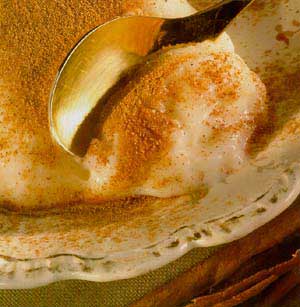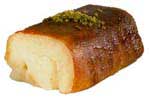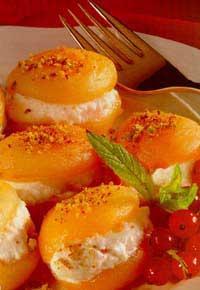Turkish Desserts
 An old Turkish
saying advises one to "eat sweetly and speak sweetly". Sweets
and desserts have always been an important and distinctive element of
Turkish cuisine. That was true in Ottoman times and is just as true today.
Interestingly enough however, they also fulfill an important social and
ritual function. Halvah, a confection made from semolina, is offered on
the occasion of major changes in people's lives: a birth, a death, induction
into the army, return from pilgrimage, upon settling in a new home, enrolling
and graduating school; and also on special occasions such as praying for
rain.
An old Turkish
saying advises one to "eat sweetly and speak sweetly". Sweets
and desserts have always been an important and distinctive element of
Turkish cuisine. That was true in Ottoman times and is just as true today.
Interestingly enough however, they also fulfill an important social and
ritual function. Halvah, a confection made from semolina, is offered on
the occasion of major changes in people's lives: a birth, a death, induction
into the army, return from pilgrimage, upon settling in a new home, enrolling
and graduating school; and also on special occasions such as praying for
rain.

One of the most important holidays in the traditional calendar is the one that marks the end of the 30-day period of daytime fasting during the month of Ramazan. A popular Turkish name for the Ramazan festival is "Seker Bayrami" (literally "Sugar Holiday'), which is a sort of caps-tone to the lavish desserts prepared for the sundown meals during the holy month. These desserts are elaborate not only in their ingredients but also in their visual impact and presentation.
 The desserts and confections of Turkey bear witness to the rich history
of its people's cuisine and geography. The dessert known as "Tavukgogsu",
made with the milk-white meat of chicken breast was introduced into ancient
Rome from the Mediterranean and reintroduced into Anatolia by the Romans.
The blanc mange made in Turkey and known as "Kazan dibi" must
certainly be one of the loveliest parts of the mosaic that Turks have
inherited from the ancient civilizations of Anatolia.
The desserts and confections of Turkey bear witness to the rich history
of its people's cuisine and geography. The dessert known as "Tavukgogsu",
made with the milk-white meat of chicken breast was introduced into ancient
Rome from the Mediterranean and reintroduced into Anatolia by the Romans.
The blanc mange made in Turkey and known as "Kazan dibi" must
certainly be one of the loveliest parts of the mosaic that Turks have
inherited from the ancient civilizations of Anatolia.
Then there's "asure", a festive pudding of cereal grains, sugar, and raisins. According to a legend, it was originally concocted in the galley of Noah's ark from whatever was left in the pantry. (Perhaps the recipe is what NASA was searching for on Agri Dagi; they needn't have bothered, the Turks discovered what they needed to make good "Asure" ages ago.) The pudding is served traditionally on the tenth day of the month of Muharrem, when preparing a batch of "Asure" and distributing it to neighbors and acquaintances is still a common custom in many areas. The Ottoman palace kitchens produced a refined version of "Asure" that was blended and strained; more common folk had to chew through the grains. They still do, to great enjoyment. Many different parts of the Ottoman Empire contributed their own local specialties to the palace kitchens where they were refined and transformed into a distinctively Ottoman-Turkish cuisine
Turkish desserts usually fall into one of three categories.
 Desserts made with fruits and vegetables
Desserts made with fruits and vegetables
Many fresh and dried fruits are stewed into compotes in which the fluid is as important an element as is the fruit itself. Desserts made from apricots or figs are given a topping of fresh clotted cream and sometimes-crushed walnuts. The same topping is used on "Kabak tatlisi", an unusual dessert made by cooking pieces of pumpkin in syrup.
Milk-based desserts
These include a wide variety of puddings, some of which are baked. "Keskul" is a milk pudding made with coconut. "Gullac" is a lovely confection of thin sheets of pastry in a milk sauce to which rosewater is added. Mention has already been made of "Tavukgogsu" and "Kazandibi".
Pastry-based desserts
These include world-famous baklava, as well as "Kadayif' (made from shredded pastry baked in syrup), "Revani" (a sweet made from semolina), "Hanim gobegi" and "Sekerpare" (two kinds of small sweet cake), "Yogurt tatlisi" (made with yogurt), "Badem tatlisi" (made with almonds), and "Lokma" (deep-fried lumps of batter served in syrup).
Altogether there are about 25-30 basic recipes for desserts known but with the addition of local variations the number becomes enormous. In 1539 Suleyman I gave a huge feast to celebrate the circumcision of his two sons Cihangir and Beyazid. Archival records tell us that fifty-three different desserts were offered to guests including different-flavored and colored puddings, a variety of halvahs, pastries and cakes, and a large assortment of jams and compotes.
We'll close this article with an anecdote that brings together the elements of Turkish desserts and the Ottoman court. During a Ramazan in the early 19th century, Sultan Mahmud II decided to pay a surprise visit to the mansion of Durrizade Esseyid Abdullah Efendi just before the cannon-shot signaling the end of the fasting went off. By custom, he would have to be entertained there and Abdullah, a cultured intellectual as well as an accommodating and experienced host managed to take care of his unexpected imperial guest brilliantly, marshalling the kitchen of the women's half of the mansion to the support of the men's side. The individual courses were done to perfection and the service came off flawlessly all until it was time for dessert, fruit compote that arrived in a clumsy, illformed bowl. Appalled by the sight, the sultan asked those near him "So far everything has been served in crystal and porcelain and eaten with gold cutlery; what is that ugly-looking bowl doing here?" The host overheard this of course and immediately explained "Your majesty, my butler goes up to Camlica mountain every day to fetch drinking water from a particular spring. Rather than throw ice into the compote and risk spoiling its flavor, he fashioned a bowl of ice out of Camlica spring water."
The essence of traditional Turkish cuisine lies in the importance given to details be it an elaborate pastry or a simple stewed fruit.